
During the pandemic, many companies decided to continue their business online. There are various reasons such as maintaining distance, filling their spare time, and so on. Because everything is completely digital, companies need to develop and improve quality for customers so that they always get the best experience.
Through experience, customers get more information than before, so the experience is one of the reasons customers will buy or use your product again.
Now, this is why it is important to understand Customer Experience Management (CEM). According to Gartner, the world's leading research and advisory firm, Customer Experience Management is the practice of designing and reacting to customer interactions to meet or exceed customer expectations and, in so doing, increase customer satisfaction, loyalty and advocacy. The following is an example of customer experience management software that you can use:
Qualtrics will help provide your business with a single source of real-time customer insights to help retain customers. With Qualtrics, you can create, monitor, and manage every experience on one platform and can be accessed anytime and anywhere. In addition, Qualtrics has been used by many entrepreneurs such as Coca-Cola, Emirates, HSBC, and Harvard University.
Clicktale offers tools to monitor and manage every customer experience on one platform and can be accessed anytime and anywhere. They also analyze your customer data to give you the best knowledge about your customer. Examples of business owners using Clicktale are Three (3), ANA Airline, Allianz, dan DELL.
With Freshsales, your team can now use AI-based lead scoring, phone, email, activity retrieval, and more. More or less the features provided are the same as the software mentioned above. Their main features are 360° customer view, seamless communication, in-depth sales analytics via reports, and schedule activity. Examples of entrepreneurs using Freshsales are Tokopedia, Honda, Bridgestone, and cisco.
Now, before you want to use Customer Experience Management Tools, here are a few things to keep in mind when considering customer experience:
Mobile experience and usability are interrelated terms in web or application design. Mobile experience refers to a person's subjective feelings and attitudes when using or interacting with certain products, such as websites or applications via mobile phones. Meanwhile, usability refers to the extent to which a product is effective, easy to use, easy to learn, efficient, error-free, and satisfies users.
If you are looking for customer experience management, make sure their app or website outlook is mobile friendly. According to research on the social media management platform, HootSuite and social marketing agency We Are Social entitled "Global Digital Reports 2020", as many as 338.2 million Indonesians are connected to the internet via their cellphones. This means that it is important for you to pay attention to customer comfort when accessing your app or website via mobile.
Mobile screens are obviously smaller than laptops, so your site layout should be easy to view and use on your phone. It includes a more vertical scrolling layout with clean, easy-to-read typography. In addition, make sure it looks simple and useful for customers, such as there are menu options (example: Home, Search, etcetera.).
Also, don’t upload large files on your app or website. Very large files can hinder the performance of a website and make the website lag.
The user onboarding process (user interaction) is a short interactive tutorial on how the core features of your app or website work. It's that simple, but can be ignored and prevents new customers from leaving your app or website due to confusion.
A good user onboarding process can help you improve app or website user interaction. There are many user onboarding methods such as home pages, email campaigns, push notifications, and others.
An example of the user onboarding process is when you access the app or website, usually, you will contact to register or make an account and do leverage. Then, you can freely access the app or website (example: buying goods). By registering, usually using e-mail, you will often get an email or push notification about a promo. Those two things will attract you to re-access the app or website.
Now then, after learning all this, did you know that there is a Customer Experience Management tools created in Indonesian? TapTalk.io is a company providing chat SDK (software development kit) and Omnichannel Messaging Platform for sales, marketing, and support that allows businesses to interact directly from websites and applications to provide the best experience to your customers, supported by an interface that can be personalized according to the brand image you want to present.
Here are some of TapTalk.io excellent features: All-in-One Inbox, Disposition, Assignment Rules, Case Details, Working Hour and Automatic Messaging, also WhatsApp, Telegram, Facebook Messenger, Twitter DM, LINE, Email, and others all combined in one channel.
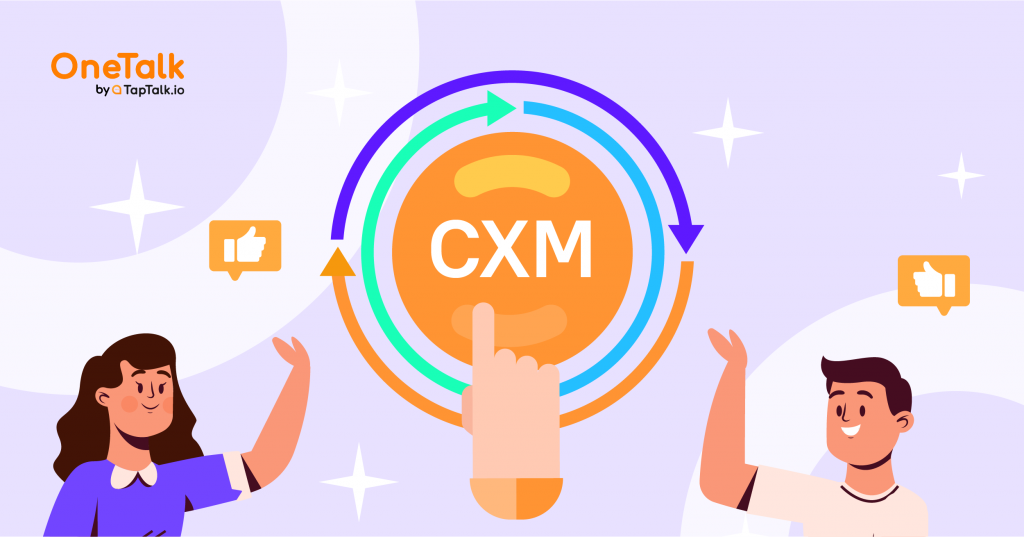
CRM and CEM / CXM are essential tools for maintaining business flow with customers. Both are there to optimize customer relationships. But, they are not the same. Similar, but different. To choose the right one, the organization must go beyond the alphabet soup of this tech business application.
What's the difference between CRM and CXM?
Customer relationship management (CRM) software tracks sales leads and customer interactions. CRM facilitates the development of relationships for organizations. CRM systems have many advantages, but not all businesses need them.
Customer Experience Management (CEM or CXM) is a broader information gathering process for tracking, monitoring, and managing all interactions between customers and organizations throughout the customer life cycle. Focus on unique perspective insights by digging deeper into the customer experience, listening to the customer, analyzing feedback, understanding the customer's perspective, and optimizing the customer experience.
In short, both tools optimize customer relationships. How they do this makes all the difference. CRM helps build relationships with your organization. CXM focuses on monitoring and improving the customer experience.
Customer experience management (or CXM) is the practice of the experience of every customer across all touchpoints and departments. A better CXM helps businesses have a better brand impression, retain more customers, and even convert them into brand advocates.
A CRM system, or Customer Relationship Management, is an application that focuses on your sales team. Starting with databases for maintaining prospect and contact information, and over the years, CRM capabilities have evolved to acquire business leads, develop them through automation, and enhance your customer relationships. Meanwhile, Customer Experience Management is an extension of the CRM system that can be extended for the entire organization. The CXM platform can map your entire customer journey to your business across sales, marketing, support, social media, and operations.
It can be used to integrate all departments by facilitating smooth and collaborative data flow across multiple communication channels. This provides a complete picture of the customer and seamlessly switches relevant customer information from one channel to another, enabling customer-facing employees to respond quickly to their needs.
Why does CRM no longer effective?
According to Thryv Vice President, Ryan Cantor, collecting customer preferences can be "amazingly fun" using data and technology. To pursue this superior customer experience, companies have spent millions of dollars adopting their own CRM platform. This ended pretty quickly.
Adopting CRM alone does not improve the customer experience. They tend to overdesign, complicate issues, get excited about technology, and forget their original purpose. Without a human touch in the middle, it was just cold, emotionless data.
Even worse, in this digital era, CRM does not have what it takes to store all the important data needed for modern business: activity on websites and mobile apps, emails, push notifications, support tickets, payment systems, and more.
What is lacking is customer interaction. Customers need to be the focus of solutions aimed at improving the experience. That's why it's time to turn into CXM: Customer Experience Management.
Very few traditional CRMs include a portal that connects to customers. It relies on bespoke messages, reminders, and notifications to maintain a certain level of customer engagement, but there is no centralized command center.
Important Note: Concentrating all the tools and services that impact customers into one system can significantly improve business efficiency. However, the difference between CRM and CXM is that it allows customers to experience the same experience in real time.
Can do more than simply talk to you and your company through a website, it can actually improve the customer experience.
Your data will be more accurate and timely if your customers can interact directly with you using the same technology that your business uses. Customer inquiries instantly reflect real-time behavior and status. This allows employees to provide more accurate and useful assistance.
Another bonus, this will also help your sales reps land more deals, and it will generate the positive reputation it needs to grow. If you're using multiple systems, or if you're only storing customer data but can't make it viable, throw away your current strategy and try CXM.
One of the tools that can improve the CXM is using an omnichannel messaging platform, such as OneTalk by TapTalk.io. With OneTalk, as a trusted omnichannel messaging platform, you can have a lot of features to make your customer’s experience delightful and amazingly fun. OneTalk's omnichannel feature allows your agent to handle multiple customer cases at one time. You can also keep an eye on your agents’ work and drive your sales and marketing up at the same time.
This kind of tool will improve your sales, marketing, and support. And, not to mention, all of the other tools that actually will improve your customer service experience.

Menjalani rutinitas customer service memang selalu berwarna. Tentu selalu ada berbagai macam kepribadian dan model pelanggan yang kita hadapi sehari-hari. Namun, bagaimana kita harus bersikap saat menghadapi pelanggan yang marah dan disaat yang sama harus tetap menjaga sikap kita?
Karena agen adalah citra perusahaan, bagaimana menyikapi pelanggan yang marah akan menjadi suatu hal yang penting. Oleh karena itu, seorang agen customer service harus mengerti kiat-kiat khusus untuk tetap tenang saat menghadapi pelanggan yang marah.
Berikut ini ada beberapa tips menghadapi pelanggan yang marah, yang bisa kalian gunakan untuk tetap tenang ketika keadaan memanas.
Ketika kita mendengarkan luapan amarah dari pelanggan, biasakan untuk memahami terlebih dahulu akar permasalahan yang dihadapi oleh pelanggan. Posisikan diri sebagai pelanggan dan pahami pola pikir dan perasaan pelanggan. Di sini, seorang agen customer service harus bisa menyimak dibanding hanya mendengar.
Simak cerita dan rasa frustasi pelanggan lebih dari kita berbicara. Ingat, kita memiliki dua telinga dan satu mulut, yang berarti kita harus bisa mendengarkan lebih dari kita berbicara. Untuk itu, coba praktikan mendengar secara aktif. Bagian penting dari mendengarkan secara aktif adalah memastikan Anda dan pelanggan berada di halaman yang sama. Jadi, setelah Anda menentukan akar penyebab kemarahan, ulangi kembali kepada pelanggan apa yang Anda dengar untuk memastikan Anda memahami satu sama lain, dan untuk memberitahu pelanggan bahwa kekhawatiran mereka telah didengarkan dan akan ditanggapi. Saat kita mencoba berbicara secara terus menerus ketika pelanggan sedang meluapkan kekesalannya, keadaan bisa berada di luar kontrol secara drastis. Pastikan Anda tetap menunjukkan support dengan berbicara tepat pada waktunya.
Praktikan “mendengarkan reflektif”. Maksudnya adalah, saat menjawab keluh kesah pelanggan anda menjawab dengan merefleksikan apa yang mereka katakan. Pendekatan ini mengharuskan Anda memahami apa yang dikatakan pelanggan dengan menafsirkan kata-kata dan bahasa tubuhnya. Kemudian, tanggapi dengan merefleksikan pikiran dan perasaan yang Anda dengar kembali kepada pelanggan Anda.
Misalnya:
Pelanggan: "Saya tidak habis pikir, mengapa kalian tidak bisa mengerti bahwa anggaran kami terbatas dan tetap tidak bersedia menawarkan diskon kepada kami?".
Customer Service agent: "Baik, jadi yang saya tangkap adalah bahwa harga yang kami tawarkan merupakan hambatan bagi bisnis Anda. Anggaran Anda terbatas, dan saya tidak menawarkan diskon yang dapat membantu kebutuhan Anda. Benar?"
Jika Anda sudah cukup memahami sentimen mereka, lanjutkan. Jika tidak, katakan, "Ceritakan lebih banyak, agar saya bisa lebih memahami." Jangan pernah berjanji Anda akan memperbaiki situasi - karena Anda mungkin tidak bisa. Tujuan Anda saat ini adalah membuat pelanggan Anda merasa didengar dan dihargai.
Ingat, bahwa meskipun Anda adalah citra dan luaran dari perusahaan Anda, tujuan komplain pelanggan adalah kepada perusahaan Anda dan bukan Anda. Pahami bahwa mereka marah kepada situasi yang mereka rasakan dan temukan saat ini. Karena, pada akhirnya, Anda dan pelanggan sama-sama mencari hasil yang positif. Anda perlu belajar bagaimana mengabaikan serangan pribadi, sarkasme, melebih-lebihkan & bahasa kotor. Ini sangat sulit karena naluri alami kita adalah untuk bertahan dan melakukan serangan balik.
Ketika pelanggan Anda terdengar marah dan negatif tentang suatu situasi, berterima kasih kepada mereka karena menyuarakan keprihatinan mereka kepada Anda dapat sangat membantu dalam membangun hubungan dengan mereka. Ucapan terima kasih sederhana untuk mengakui waktu dan kesabaran mereka saat Anda berupaya menyelesaikan masalah sudah cukup.
Contoh:
Cara termudah untuk berterima kasih kepada pelanggan Anda adalah dengan melakukannya terus-menerus. Saat pelanggan memulai pertanyaan tentang layanan, ucapkan terima kasih karena telah menghubungi tim Anda. Saat Anda mengerjakan kasus dan ada waktu diam yang lama, ucapkan terima kasih kepada pelanggan karena "mendukung Anda saat Anda memecahkan masalah mereka". Dan, ketika pelanggan memberi Anda umpan balik, baik positif atau negatif, ucapkan terima kasih kepada mereka karena telah membagikan perspektif mereka dan membuat tim dukungan Anda lebih baik.
Tentu saja, jika Anda dapat melakukan apa yang diinginkan pelanggan dari Anda, Hebat! Jika Anda tidak bisa, persiapkan solusi lain yang akan sesuai untuk pelanggan dan masalahnya.
Manfaat terbesar dari tidak mengambil sesuatu secara personal dan bereaksi seperti itu adalah kesadaran diri dan pemahaman. Jika Anda dapat belajar memilih tanggapan yang lebih baik, Anda akan menjadi tidak tergoyahkan, tidak peduli apa kata pelanggan yang marah itu. Dalam pekerjaan layanan garis depan, ini adalah sifat yang penting untuk dimiliki. Untuk dapat berada di sana untuk pelanggan Anda, dan dapat pulang di penghujung hari dengan sikap positif dan cinta untuk pekerjaan Anda, bahkan setelah hari yang buruk.
Hal terakhir yang harus kita lakukan adalah membalas komplain pelanggan dengan cepat. Misalnya saja menggunakan aplikasi perpesanan omnichannel. Salah satunya OneTalk yang menawarkan fitur yang mempermudah. Fitur omnichannel pada OneTalk memungkinkan agen Anda menangani berbagai case pelanggan dalam satu waktu. Dengan demikian, lamanya waktu tunggu tidak akan memperburuk situasi.
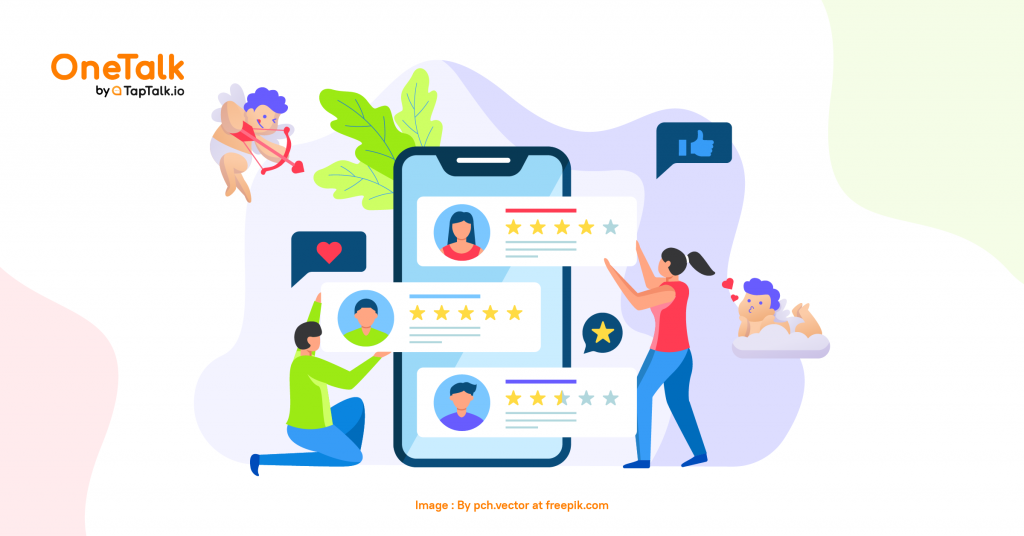
In every business, customers play a crucial role. They have the power to make your business succeed or fail. Other than that, the customer could also be a free advertisement. How come? The thing is, when a customer becomes a loyal buyer and is satisfied with your product, they will review and recommend your product to their friends and family. The key to loyal customers is the outstanding customer service your business delivers.
Here are some tips on how to build your loyal customer base:
If you meet someone once, and they remember your name and specifics of your last conversation the next time you see them. Wouldn’t you be happy? For consumer loyalty, this is huge! Businesses should aspire to remember their clients. Try sending them “Happy Birthday” on their birthday and sending personalized messages.
When they feel respected, clients are more likely to be loyal; do you know their birthdays, or the ages of their parents, or the last thing they bought? During a customer's birthday, you should offer them a special offer or discount. Everyone loves a birthday treat!
Being open about your business with your clients is also important. Are you going through a tough patch of packages coming out on time? Oh, let them know. Did you just recruit a new CEO or get an amazing new product released? Give the clients a customized message, giving them a heads-up before the story gets to the newspapers. Even better, send it to your committed, trustworthy clients first to get truthful reviews.
Create a program to appreciate your loyal customer. For example, every time your customer buys your product, give them reward points. If they collected enough points, your customer can exchange something from you, such as a product, voucher, or point that can be used to cut the price of your customer’s future shopping.
Your customer will be excited to buy your product to collect these amazing points. Or you can give them a referral code program. Every time your customer shares the referral code to their friend. They will receive a bonus. But, you need to make sure your customer’s friend input and use the referral code.
You can receive data about them when they sign up for your business. Store your customer data, such as birthday, email, phone number, favorite or most purchase product, and others. Offer them something similar based on their last purchase.
You also need to decide on your own customer market. For example, you are selling dress and blouse, probably your business buyer history will be dominated by women right? Your business idea customer will be most women in the world. Do some research on it, look at the trends. So when they are looking at your shop, they will think “Ah.. this store is update with fashion season”. Knowing your business is always update will encourage your customer satisfaction
Be an attentive business owner, listen to their complaints and reviews. This will help you to develop your product better than before. Via platforms like Twitter and customer forums, you can also have excellent customer support. When a problem is settled or a purchase is complete, reach out and inquire about the experience of your client.
Automated email systems such as newsletters are another way to inquire for feedback. Send a prompt to check the business for an exclusive discount after a client has made a certain amount of transactions. Use them in the surveys if you deal with consumers.
Those are some tips on building customer loyalty. Omnichannel offers features based on the tips above. You can use disposition and customer detail features. With Disposition, you can create and summarize the Disposition of each incoming case to get business insights from your customers. The goal is to gain insight to reduce similar cases in the future, gain insights to reduce similar cases in the future, and generate new business ideas.
Through Omnichannel’s feature case detail, you can understand your customers further by knowing how long they have been waiting, their history, the channels they use, and many other things.
Omnichannel also offers User Session Synchronization to make it easier for your customers to contact you by connecting to their login session, so that your customers don't have to enter their information again. You can store your customer data using this feature. There will be no more duplicate customer data, easily access your customer case history, and make it easier and faster for the flow of engagement with your customers.
There are many messaging channels offered by Omnichannel, like WhatsApp, Telegram, Facebook Messenger, Twitter DM, LINE, Email, and more. This will make it easier for your customers to contact you through various channels and reach them more conveniently.
By the way, a little tip, you need to specialize in your design brand. Let’s take the example of Louis Vuitton. Who doesn’t know their famous pattern? If someone walks in with a Louis Vuitton bag you will instantly know it’s their product. By creating unique designs, your customer will literally be a walking advertisement.
Get to know our Omnichannel product OneTalk by contacting us through email hello@taptalk.io!
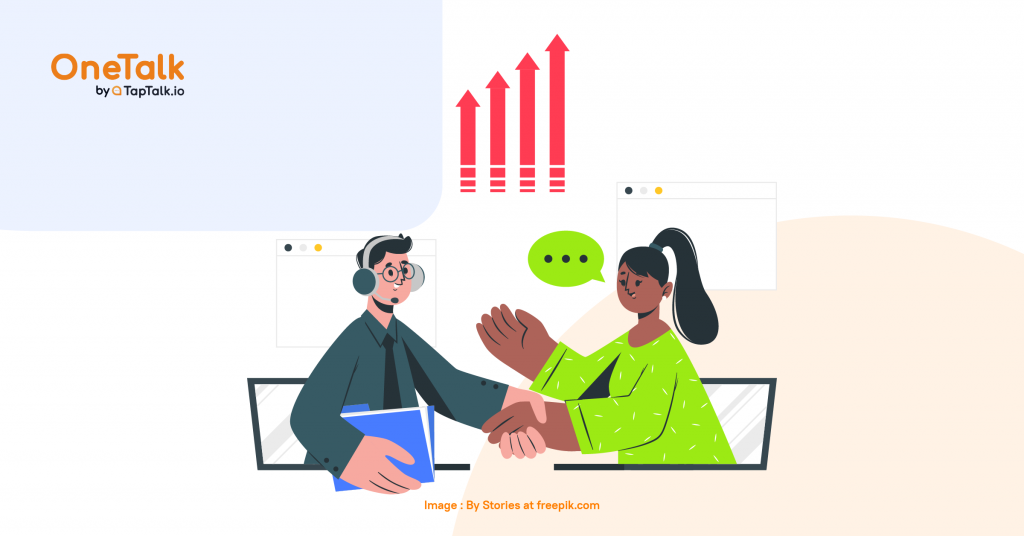
Customer service adalah hal terpenting bagi bisnis untuk berjalan dengan baik.
Customer service yang hebat dapat mengatasi pemasaran yang buruk, tetapi sangat sulit (dan mahal) untuk mengganti customer service yang buruk dengan pemasaran yang paling luar biasa dan "menyenangkan". Oleh karena itu, Anda tentunya harus mengikuti pola bisnis saat ini dengan meningkatkan kualitas customer service untuk menunjang brand trust dan brand image yang baik.
Salah satu akibat dari customer service yang buruk adalah rusaknya reputasi perusahaan. Brand image dan brand reputation perusahaan Anda sangat berharga dan bukan sesuatu yang ingin Anda acuhkan. Apalagi, terutama di era digital, reputasi Anda adalah hal pertama yang terpengaruh ketika Anda memiliki customer service yang buruk.
Sebuah perusahaan harus bisa mempertahankan brand image yang baik dan berkesan bagi customer. Ini adalah fakta yang harus terus menerus digunakan dalam bisnis. Mengutamakan kebutuhan pelanggan menjadi acuan dalam segala strategi bisnis yang kita berikan. Dengan menunjukkan citra atau brand image yang berpusat pada kepuasan pelanggan, tingkat pemasaran dan penjualan akan meningkat.
Jika perusahaan tidak siap untuk menunjukkan pelayanan terbaiknya kepada pelanggan, maka pelanggan pun akan memberikan kesan yang tidak baik pada layanan dari perusahaan tersebut. Jangankan loyal customer, kecil kemungkinan pelanggan itu akan memberikan tanggapan baik terhadap perusahaan. Terlepas dari sebaik apapun barang atau jasa yang ditawarkan oleh perusahaan, pelanggan hanya akan merasa nyaman menggunakan barang atau jasa tersebut jika diperlakukan dengan baik.
Selain itu, jika hal ini terus menerus berlangsung, Anda dapat kehilangan karyawan-karyawan terbaik Anda. Ketika perusahaan Anda memiliki masalah customer service, karyawan terbaik Anda dipaksa untuk mengisi pekerjaan tambahan untuk menutupi kinerja karyawan yang buruk. Hal ini menyebabkan kelelahan dan ketidakpuasan dari karyawan Anda yang sudah bekerja dengan maksimal.
Apalagi, jika mereka menyadari keadaan bisnis yang menurun, mereka mungkin akan berpindah pihak kepada perusahaan lain yang lebih menjanjikan.
Buruknya customer service juga dapat berakibat buruk pada profit perusahaan. Ketika reputasi sudah mulai menurun dan Anda kehilangan penjualan, maka Anda berada dalam masalah yang lebih besar. Anda akan terpaksa memilih untuk memotong biaya dan mencoba bertahan atau apakah Anda menggandakan pemasaran untuk menarik pelanggan baru?
Kualitas customer service dapat mengubah pilihan pelanggan dengan menghasilkan brand image yang berbeda. Pelanggan yang mulanya menggunakan barang atau jasa perusahaan yang lebih dikenal dan besar, bisa saja berpindah hati jika menemukan perusahaan lain dengan customer service yang lebih baik dan lebih responsif.
Singkatnya, kualitas customer service akan mempengaruhi penjualan dan pemasaran perusahaan Anda. Untuk itu, bagaimana menjadikan kualitas customer service perusahaan Anda menjadi lebih baik dan responsif?
Bagaimana memperbaiki kualitas customer service?
Tentu, anda bisa melakukan pemantauan sendiri terhadap customer service Anda, tetapi akan menjadi sulit melakukan hal tersebut setiap saat di semua channel, bukan?
Omnichannel dapat membantu Anda untuk mencapai hal ini. Omnichannel adalah pendekatan terintegrasi untuk proses yang berpusat pada pelanggan yang menggabungkan satu sistem manajemen dari berbagai channel untuk meningkatkan kepuasan pelanggan dan pengalaman customer sebagai salah satu social messaging solution. Singkatnya, omnichannel membantu menyatukan banyak platform pesan agar memudahkan kita merespons customer.
Keuntungan dari omnichannel customer service adalah bahwa ia mengintegrasikan beberapa platform pengirim pesan sebagai cara berkomunikasi dengan customer. Hal ini membuat Anda tidak lagi perlu membuka banyak saluran komunikasi sekaligus, tetapi menyatukannya dalam satu dasbor dan platform.
Beberapa fitur yang ditawarkan oleh jasa omnichannel dapat memastikan kinerja agent anda. Misalnya pada penyedia jasa omnichannel OneTalk, terdapat fitur All-in-one-inbox yang bisa mengintegrasi semua pesan dari customer dalam satu platform. Fitur ini akan memberikan pekerja Anda sebuah alat untuk menangani pelanggan dengan lebih baik dan lebih efisien.
Untuk melakukan peningkatan kualitas customer service dengan berpusat dengan kepuasan pelanggan, terdapat fitur Disposition. Fitur Disposition memastikan sebuah perusahaan tetap mendengarkan dan mengintegrasikan semua komplain dan masalah customer menjadi sebuah ide konstruktif.
Disposition membuat dan meringkas disposisi setiap kasus yang masuk untuk mendapatkan wawasan bisnis dari pelanggan Anda. Data-data yang terekam adalah, mengetahui sudah berapa lama mereka menunggu, history mereka, channel yang mereka gunakan, dan banyak hal lainnya. Fitur ini juga membantu Anda menyimpulkan kasus untuk menghindari kasus serupa di masa mendatang dan memunculkan ide bisnis baru.
Hasil integrasi dari fitur Disposition menghasilkan analitik dari setiap kasus yang masuk dalam customer service. Kesimpulan ini akan membantu Anda agar kasus dan masalah yang terjadi tidak terulang lagi di masa depan. Hasil analitik ini juga lah yang nantinya dapat ditampilkan di website Anda untuk menarik minat pelanggan terhadap produk atau layanan yang disediakan oleh perusahaan Anda.
Dengan “menonjolkan” kelebihan produk dan pelayanan Anda terhadap customer melalui testimoni ini, peluang keberhasilan strategi pemasaran perusahaan Anda akan bertambah. Anda akan menonjolkan kualitas customer service milik perusahaan Anda dan dapat bersaing dengan kompetitor yang lain.
Dengan semua alat yang disediakan oleh OneTalk sebagai platform omnichannel, Anda memberi karyawan Anda customer service yang sangat terdepan. Meningkatnya kualitas customer service anda akan berbanding lurus dengan peningkatan sales dan marketing, juga brand image dan brand trust perusahaan Anda.
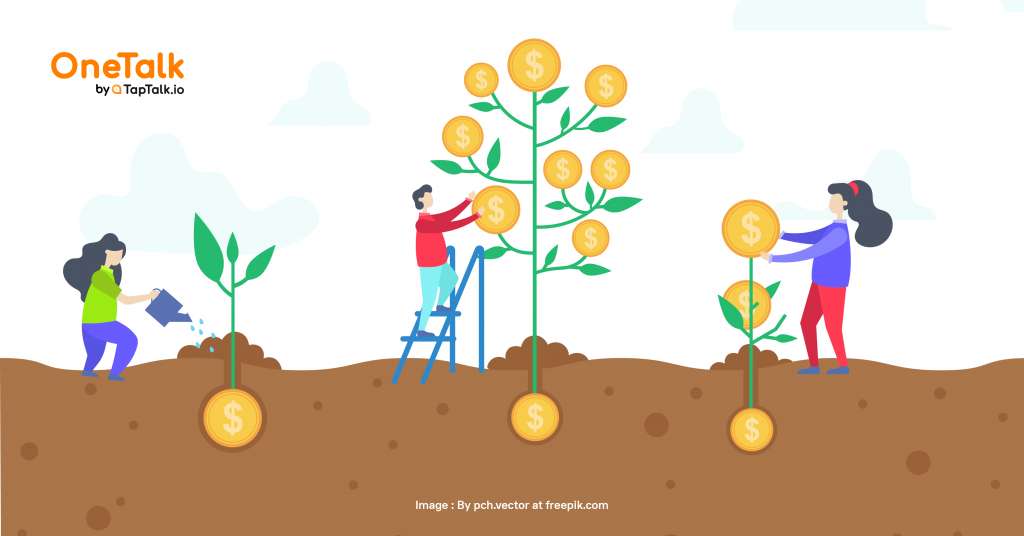
Companies need to think harder than ever on how to receive a big turn on the marketing aspect at absolutely no cost. But how do we exert little to no marketing cost but still receive a big impact? How do we increase our sales and still gain new customers without that much money flying around to make our products known?
We will get into it one by one in this article.
Content optimization
Fill the internet with as much as your product as possible. Or, at least, the SEO. There is a lot of ways to share your content worldwide so they can be recognizable to people. Blogs can enhance your chance at being the top in Google Search because you can optimize the use of Search Engine Optimizations (SEO). If you do it right, your website can be on the first page. And, if you got into the first page, your company will achieve more reach and engagement from potential customers.
It takes a little effort to do this without actually spending money on other forms of advertisement. Fill your website with blog content so you can reach a lot of people. Your blog should be filled with informational content, as much as you post marketing content for your stuff. It is important to do a repetition of your products’ benefits so that your customers are used to it.
But the internet is not just Google, right?
These days, a lot of online platforms can be optimized as a content-sharing platform. Optimize other platforms such as Youtube. You can make a low-cost video for a Youtube channel. Enhance your video with great editing skills to make your customer comfortable with your video. Use an easy language and words. Make it as light as possible and explain it to the point. Of course, you also need to make the right title for your video to earns maximum reach.
Optimization of Social Media to post your content
Make your social media as a canvas to create the best marketing strategy. Use it to interact with your customer. Analyze, publish, and make customer engagement with people across the world. Social media can be used to align marketing with customer service, and therefore strengthening customer relationships.
You can divide your effort on social media into two things. The first is about social media campaigns. In these aspects, you can post all about your products or services. Use social media platforms with the most users, such as Instagram, Facebook, etc. Post on How your products work, how it was supposed to work, and how it can help your customer’s needs. Be what they need and want and emphasize it in your social media. Don’t forget that visual is as important as the other stuff.
The second is building relationships with your customers. Engage and connect with them as much as possible. Not only you need to build a relationship with them, but you also have to make sure it is a meaningful one. Good customer engagement will result in loyal customers.
Networking Online
Collaborating with others is great too! Both of the participants can increase each other popularity by being seen in other platforms with different people other than their customers. Do it constantly and engage others. Don’t forget to show your sincerity when you do the work. The goal of this point is to reach new people as much as possible.
Be a speaker
Another free advertisement but also a knowledge-sharing experience is being a speaker. When you master a field and you are good at delivering speeches about that field, being a speaker is a way to spread awareness of your products. It doesn’t have to be a hard selling speech. But your title when you do become a speaker is step one of rising product awareness.
You become the mascot of your company when you try this. You showcase your digital presence and engage with new faces that can be potential customers. This will require you to convince them that you are good at what you are doing and therefore your product is a real testament as a good example of it.
For example, if you are being the speaker about omnichannel, those who never even heard of it will know you as their first connection to what it is. Participate free or paid, it doesn’t really matter. Your product will be the first thing that they know about omnichannel. And then, new potential customers will be considering using your products.

In an era with software and digital development, creating a culture of knowledge sharing is easier and just as important as selecting the best knowledge. Sometimes, the more knowledge you know, the fewer employees are inclined to share it. This will be where you, as a business leader, should intervene and make it right. Now, we no longer live in a time where organizations can thrive with siloed information, with only a few people hold the key to the castle.
Knowledge sharing will lead to organizational transparency, which in multiple studies has proven good for business. It promotes the healthy, sustainable growth of modern businesses, regardless of industry. Several reports have shown that business transparency - both external and internal - is very expensive these days. Clients prefer companies that are honest with them, and workers consider internal transparency one of the most important factors when considering a new job.
The principle of radical business integrity is the first step towards building an organization in which employees are primarily motivated to share their experiences with colleagues. When your company's ecosystem supports the free flow of information, you not only make it easier for your people to do a good job, but you also gain benefits when it comes to bringing in the best talent.
But this culture would require a good work environment so the employees would feel safe and comfortable doing it. That was because knowledge sharing is not just about creating a knowledge base or even setting up some internal wikis. Knowledge sharing culture puts people and collaboration first. There must have been a willingness of teammates to help each other out.
According to Slack, there are three things to cultivate a healthy collaboration culture: Leadership should lead by example, be accessible to employees; feedback cycles should be encouraged among employees, management, and departments; Psychological safety should be prioritized to ensure that employees feel comfortable sharing expertise with one another without fear of competition or job instability. It makes employees more open to what they don’t know.
The next step after making it a “safe zone” for your employees to adapt knowledge sharing culture is them actually learning how to do it. Practicing skills is a more effective technique rather than simple theoretical learning. The more you encourage your employees to work with one another to practice knowledge sharing, the more effective it will be rather than an interaction between them and wiki━which can possibly be out of date or lacking tacit knowledge. That is why you need to try to keep people engaged by designing any knowledge management tool that you invest in around a people-first philosophy.
Knowledge sharing culture is an employee retention insurance
When you practiced a good knowledge sharing culture in your work environment, you could avoid losing team’s productivity due to the lack of an instrumental member at work. Workers won’t hoard expertise, all the skills and expertise would be shared among them equally.
So rather than a single precious employee, you could have dozens of expert workers. A company that practices knowledge sharing culture makes for happier and more loyal employees who could survive a teammate’s departure. Employees will be vested in a company that creates a comfortable and positive work environment for them.
Increase overall productivity with knowledge sharing
Knowledge sharing will enable a company to learn from mistakes and increase employee engagement to the company. Employees’ professional growth can benefit a company greatly. Research around the world has shown that knowledge-sharing initiatives driven by a culture of learning and collaboration can naturally increase employee productivity as a whole.
When employees can benefit from a knowledge-sharing culture, they are less likely to face hardships alone and are more likely to collaborate productively and think innovatively. All of this can lead to new customer solutions or product offerings, keeping your organization competitive and successful.
Simply put, transparent organizations that support knowledge sharing are self-sustaining organizations: these multiply opportunities for growth while creating employee ownership and participation. Who among us would not want to invest in a cultural strategy that can afford it?
It’s time to embrace a knowledge-sharing culture. That starts with taking a good look at how your company’s knowledge management works and starts doing an evaluation. Don’t forget to also provide your employees with the tools they need to succeed and grow.
An organization that is actively involved in sharing knowledge is at the forefront of everyone. Spending energy creating this culture of engagement requires an ongoing focus that advances employee engagement and empowerment.
In TapTalk.io, knowledge sharing is a must. As a startup, it was an important thing to nurture. Our team works collectively as a family because of our transparency. Because of the collective work and the knowledge sharing culture, we are able to increase our productivity and build a healthy environment.
Hope this is helpful!

A business should cover all aspects before they launch their products or services. What would you provide and prepare before you launch your product? Would that be the idea that you share when you brainstorm your strategy? Ask your company some questions before you “think” you could provide your customer with what they need with your product. You need a good Product Judgement from your customers to know “What do they really need?” is what you really need to think through before your products meet the markets.
Product Judgement is the notion that you can use your own judgment to (1) accurately predict what customers need, what they want and value, and (2) develop and provide them with a solution.
Product Judgement does exist and it is learned. No one starts with a strong product rating. It is not innate. It took years to build and therefore ranged from very weak to very strong. It takes mature work and dedication to create it. Therefore, some have it, others do not.
Product Judgement is obtained through customers. That’s why you have to learn from your customers with their perception. Good businesses will assess their market before they launch their product. You have to know “who are you dealing with” and your product should be the answer to all of their needs. To know who you’re dealing with, you can control your Product Judgement by personally observe and correspond to them.
But you have to make sure that your products, or the way that you market your products, will make it easier for them. Customers hate it when things are complicated. Because we have to provide their needs, we need to provide them with the convenience that they demand.
You also need to make sure how your customers view your product and the way that you portrayed and presented your products.
Research by Cruz and Duarte (2011) has proven that “by designing and presenting assistive products as general consumer goods it may be possible to reduce stigmatic elements from being associated with them”. This practically means the way you present your product will affect their willingness to buy. This is why you need to study your Product Judgement by placing yourself in a customer’s place and keep a good relationship with your customer. What are the contextual aspects that affect customer’s decisions?
You need to ensure how your products are perceived by your customer. It is important to make unique products, but it is also great if you make the same products but BETTER. To make it better, you need to constantly follow the trend.
Now, after contemplating how you present your product, the next thing you need to do is “be them”. To know how your product or service is perceived and how is your Product Judgement, you have to use it yourself. You have to know all about it, how it works, and how it was supposed to work.
Creating a great product touches on many areas. From what problems a product solves, to how it solves them, to how it is evaluated and positioned in the market.
Product Judgement is an ever-evolving thing. Because of the change in trends, technologies, competitors, and industries. Present your product according to what the trend is. Filter their trend. Watch your competitors. Study the industries where your products grow.
When you portrayed your products or services as something that they need in everyday life and without disabilities, your customer will be convinced that they “should” be using your products or services.
Because Product Judgement is a never-ending journey, you have to keep checking and refining it. When you apply your product judgement and decisions get made, go back and check those decisions again. Never stop evolving, keep talking to the market about your product. Present them as consumer goods so they can “think that they “need” you before they actually need you.
But that perfect notion and concepts will make you think hard and question how could such a great Product Judgement exist?
You can be the one to make such a thing!
Don’t ever doubt that you can do it too. Do the research to the customers that are using your products. You can study with as many respondents as possible. You just have to get started and the numbers add up quickly. The best part is that you will start to feel like your judgment is growing. To get high product ratings, you have to fall in love when you talk to customers. Overcome the obstacles you have today.
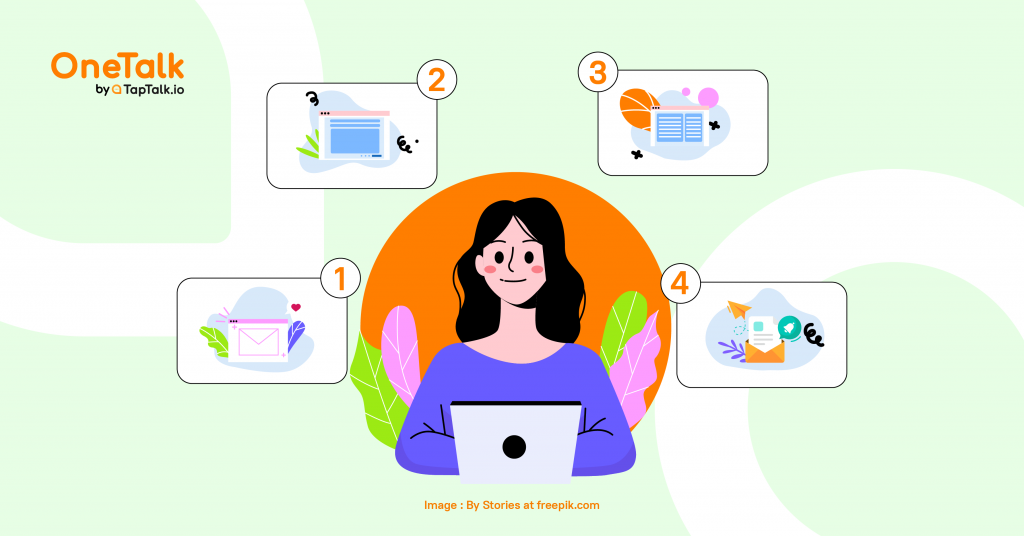
Companies use email as other ways to connect with their customers. They could send information regarding new products, promotions, and others to their customer by using monthly newsletter blasts. Newsletter blast is a process of sending details and product-focused content to a subscriber list which includes existing and potential customers via an emailed letter.
The newsletters contain a variety of items not linked solely to shopping. In a given topic of a newsletter, businesses might include anything from business news to fascinating facts and "how-to" articles. Since customers have already shown that they are interested in receiving the newsletter, businesses should produce more valuable content that they know will engage their base.
However, customers can unsubscribe your newsletter if they find it annoying and disturbing. You don’t want customers to miss out on any exciting news from us. To solve this problem, you need to create good newsletter strategies.
Here are some tips to create a successful newsletter that your customer wants to read
People receive many newsletters every day. You have to make sure that your subscriber wants to read the newsletter you send. Try using a special, innovative subject line for any email you send. Your subject will tell your reader what they are going to read, and do not use deception to trick them into opening an email. The general rule of thumb is to have about 50 characters or fewer on the subject line. Avoid using words like “Free”, “limited time” and don’t use all caps on your subject. You don’t want to scream at your customer.
Of course, you want to put adverts on your newsletter. But make sure to put something else to keep your readers interested. You could provide tips and advice articles, or news regarding your company. There are the key things that your subscriber may be interested in.
You need to be consistent with the newsletter so your subscriber knows what to expect when the open and read it. Make sure your subscribers don't feel fooled because your subject line has little similarity to the newsletter material. Don’t forget to send them regularly so your customer didn’t forget about you.
Ensure people can quickly and conveniently get the information they need from your newsletter. Also, don't use too much detail and too many separate papers to fill your newsletters. Even though you've been dreaming about loads of posts for your first newsletter, you don't even have to bring them all in.
You are an expert in your profession, and perhaps your subscribers are not. That means you have to describe it in terms that most people will understand and clarify any words, abbreviations, and acronyms in the industry. We all get used to our terms of business and we still forget that others don't understand them immediately too. So be careful and proofread your newsletters in pursuit of some supposed interpretation, and better clarify it.
The most convenient way to ensure your email has been sent (and read afterward) is by using "read receipts." Many webmail clients have an email monitoring option these days. You may choose to be informed when a recipient has either received or read your message before sending your message.
Nowadays, a variety of email monitoring tools is available, enabling sales teams to have more power as well as access to useful data. One of them is CRM (Customer Relationship Management) software.
Email monitoring tools have become a crucial part of reaching prospects and customers — old and new — at every scale. And the use of CRM with email monitoring capability has become more relevant for organizations to meet their customers at the right time and in the right sense.
Email monitoring is the ability to control the status of emails you deliver, to boost visibility and company with your customer. Through using an email monitoring app, you'll be able to receive real-time email updates for each email case. It also helps you monitor your high-funnel email measurements on an ongoing basis as email opens and click-through speeds, so you can make better business decisions.
Monitoring emails lets you directly communicate with your customers and prospects by letting you see when your emails are sent and opened. When you open your prospects and click on the link in your newsletters, you know when they actively interact with your company. You will also see how many times your emails are opened, and watch the links they clicked on. This helps you to recognize your future clients so that you can contact them at the right time or deliver the next follow-up note, and improve your chance of attracting their company significantly.
You can use CRM software such as Keap, Zoho, Hubspot, Salesforce, ActiveCampaign, and many others, you can easily find CRM software on the internet.
Reach us by phone at (021) 27939266
© 2020 - 2023 TapTalk.io (PT Tap Talk Teknologi)
